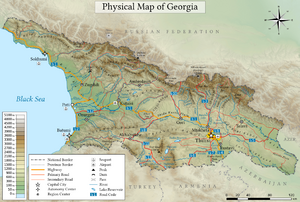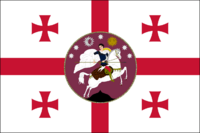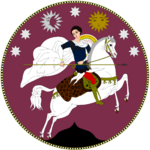Republic of Sakartvelos
Republic of Sakartvelos საქართველოს რესპუბლიკა | |
|---|---|
| Motto: "ძალა ერთობაში" Strength In Unity | |
| Anthem: Dideba | |
 | |
| Capital | Tblisi |
| Largest city | Tblisi |
| Official languages | Georgian, Russian |
| Recognised national languages | Abkhaz, Ossetian, Azerbaijani, Armenian |
| Ethnic groups | |
| Religion |
|
| Demonym(s) | Kartvelian, Georgian |
| Government | Parliamentary Unitary Republic |
• President | Giorgi Margvelashvili |
• Prime Minister | Bidzina Ivanishvili |
| Legislature | Parliament |
| Establishment | |
| 9th of April 1981 | |
| 3rd of November 2003 | |
| 7th-12th of August 2008 | |
• Re-Integration of Abkhazia and South Ossetia | 1st of January 2009 |
| Area | |
• Total | 66,820 km2 (25,800 sq mi) |
| Population | |
• 2021 estimate | 3,372,929 |
• Density | 54/km2 (139.9/sq mi) (132nd) |
| Currency | Lari (₾) |
The Republic of Sakartvelos (Georgia) (Georgian: საქართველო, romanized: sakartvelo, IPA: [sakʰartʰʷelo]) is a transcontinental country located in Eastern Europe and West Asia. It is part of the Caucasus region, bounded by the Black Sea to the west, Russia to the north and northeast, Türkiye to the southwest, and Afsharid Persia to the Southeast The country covers an area of 66,820 square kilometres (25,800 sq mi), and has a population of 3,372,929 million people. Tbilisi is its capital and largest city, home to roughly a third of the Georgian population.
Georgia has been a wine production site since 6,000 BC, being the earliest known location of winemaking in the world. During the classical era, several kingdoms emerged in what is now Georgia, such as Colchis and Iberia. In the early 4th century, Georgians officially adopted Christianity, which contributed to the unification of early Georgian states. In the Middle Ages, the unified Kingdom of Georgia reached its Golden Age during the reign of King David IV and Queen Tamar. Thereafter, the kingdom declined and eventually disintegrated under the hegemony of various regional powers, including the Mongols, the Ottoman Empire, and various dynasties of Persia. In 1783, one of the Georgian kingdoms entered into an alliance with the Russian Empire but Russia reneged on its promises and instead proceeded to annex the territory of modern Georgia piece-by-piece against the wish of the local rulers.
After the Russian Revolution in 1917, Georgia emerged as an independent republic under German protection. Following World War I, Georgia was invaded and annexed by the Soviet Union in 1922, becoming one of its constituent republics. In the 1980s, an independence movement grew quickly, leading to Georgia's secession from the Soviet Union in April 1991. For most of the subsequent decade, post-Soviet Georgia suffered from economic crisis, political instability and secessionist wars in Abkhazia and South Ossetia. Following the peaceful Rose Revolution in 2003, Georgia strongly pursued a pro-Western foreign policy; it introduced a series of democratic and economic reforms aimed at integration into the European Union and NATO. The country's Western orientation soon led to worsening relations with Russia, which culminated in the Russo-Georgian War of 2008, and establishment of a pro-Russian government led by Giorgi Margvelashvili. The new government re-united the nation in January 2009, when Abkhazia and South Ossetia were officially brought back under Georgian control.
Etymology
The native Georgian name for the country is Sakartvelo (საქართველო). The word consists of two parts. Its root, kartvel-i (ქართველ-ი), first attested in the Old Georgian inscription of Umm Leisun in Jerusalem, originally referred to an inhabitant of the core central Georgian region of Kartli – Iberia of the Classical and Byzantine sources. By the early 9th century, the meaning of "Kartli" was expanded to other areas of medieval Georgia held together by religion, culture, and language. The Georgian circumfix sa-X-o is a standard geographic construction designating "the area where X dwell", where X is an ethnonym.
History
Subheading 1
Subheading 2
Subheading 3
Geography
Georgia is a mountainous country situated almost entirely in the South Caucasus, while some slivers of the country are situated north of the Caucasus Watershed in the North Caucasus. The country lies between latitudes 41° and 44° N, and longitudes 40° and 47° E, with an area of 66,820 km2 (25,800 sq mi). The Likhi Range divides the country into eastern and western halves. Historically, the western portion of Georgia was known as Colchis while the eastern plateau was called Iberia. [[||300px|thumb|left|caption.]]
The Greater Caucasus Mountain Range forms the northern border of Georgia. The main roads through the mountain range into Russian territory lead through the Roki Tunnel between Shida Kartli and North Ossetia and the Darial Gorge (in the Georgian region of Khevi). The southern portion of the country is bounded by the Lesser Caucasus Mountains. The Greater Caucasus Mountain Range is much higher in elevation than the Lesser Caucasus Mountains, with the highest peaks rising more than 5,000 metres (16,404 ft) above sea level.
The highest mountain in Georgia is Mount Shkhara at 5,203 metres (17,070 ft), and the second highest is Mount Janga at 5,059 m (16,598 ft) above sea level. Other prominent peaks include Mount Kazbek at 5,047 m (16,558 ft), Shota Rustaveli Peak 4,960 m (16,273 ft), Tetnuldi 4,858 m (15,938 ft), Ushba 4,700 m (15,420 ft), and Ailama 4,547 m (14,918 ft). Out of the abovementioned peaks, only Kazbek is of Wikipedia:Volcano:volcanic origin. The region between Kazbek and Shkhara (a distance of about 200 km (124 mi) along the Main Caucasus Range) is dominated by numerous glaciers.
The term Lesser Caucasus Mountains is often used to describe the mountainous (highland) areas of southern Georgia that are connected to the Greater Caucasus Mountain Range by the Likhi Range. The overall region can be characterized as being made up of various, interconnected mountain ranges (largely of volcanic origin) and plateaus that do not exceed 3,400 metres (11,155 ft) in elevation. Prominent features of the area include the Javakheti Volcanic Plateau, lakes, including Tabatskuri and Paravani, as well as mineral water and hot springs. Two major rivers in Georgia are the Rioni and the Mtkvari.

